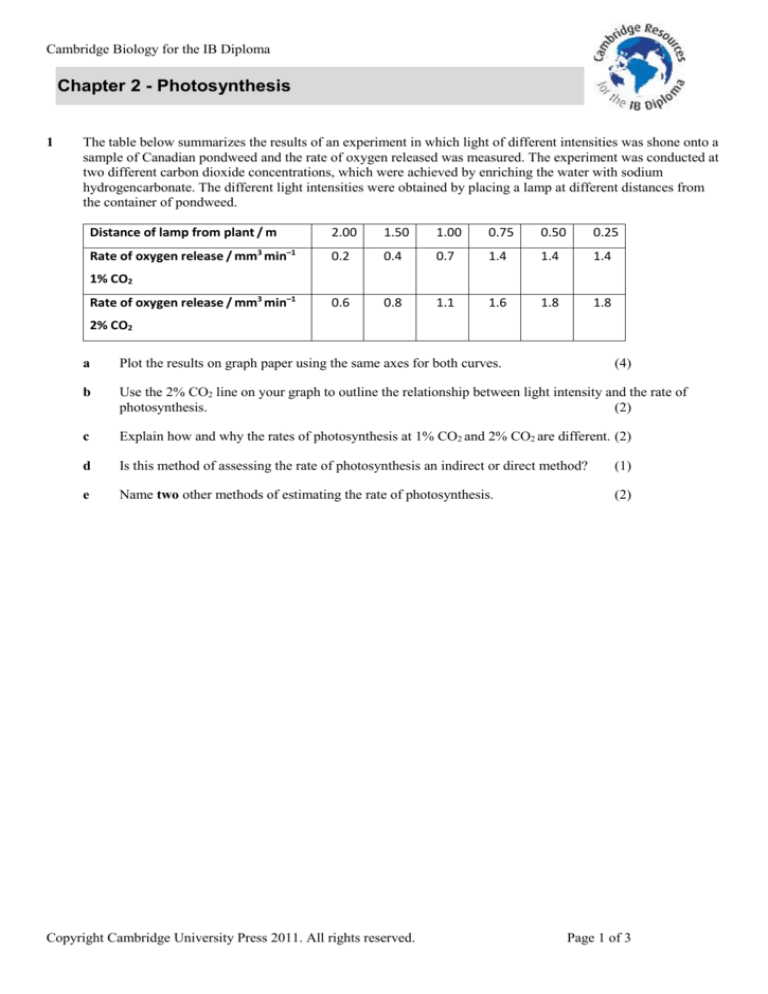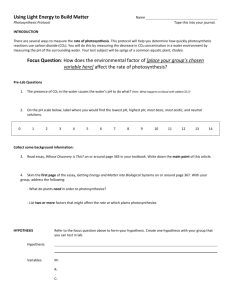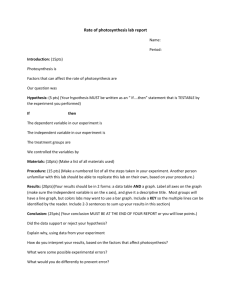
Cambridge Biology for the IB Diploma
Chapter 2 - Photosynthesis
1
The table below summarizes the results of an experiment in which light of different intensities was shone onto a
sample of Canadian pondweed and the rate of oxygen released was measured. The experiment was conducted at
two different carbon dioxide concentrations, which were achieved by enriching the water with sodium
hydrogencarbonate. The different light intensities were obtained by placing a lamp at different distances from
the container of pondweed.
Distance of lamp from plant / m
2.00
1.50
1.00
0.75
0.50
0.25
Rate of oxygen release / mm3 min–1
0.2
0.4
0.7
1.4
1.4
1.4
0.6
0.8
1.1
1.6
1.8
1.8
1% CO2
Rate of oxygen release / mm3 min–1
2% CO2
a
Plot the results on graph paper using the same axes for both curves.
b
Use the 2% CO2 line on your graph to outline the relationship between light intensity and the rate of
photosynthesis.
(2)
c
Explain how and why the rates of photosynthesis at 1% CO2 and 2% CO2 are different. (2)
d
Is this method of assessing the rate of photosynthesis an indirect or direct method?
(1)
e
Name two other methods of estimating the rate of photosynthesis.
(2)
Copyright Cambridge University Press 2011. All rights reserved.
(4)
Page 1 of 3
Cambridge Biology for the IB Diploma
2.
The rate of photosynthesis in the marine seagrass, Zostera marina, was investigated
under a range of pH conditions. After a period of darkness, the plants were illuminated
at a constant light intensity at 15°C and the rate of photosynthesis was measured.
Zostera marina can use both dissolved carbon dioxide (CO2) and hydrogen carbonate ions for
photosynthesis. The rate of photosynthesis is plotted on the y-axis on the left. In addition, the
concentration of carbon dioxide was measured for each pH investigated and is plotted on the y-axis on the
right.
[Source: Plant physiology by AMERICAN SOCIETY OF PLANT PHYSIOLOGISTS. Copyright 2008 Reproduced with
permission of AMERICAN SOCIETY OF PLANT BIOLOGISTS in the format CD ROM via Copyright Clearance Center.]
(a)
State the carbon dioxide concentration at pH 7.2.
......................................................................................................................................
......................................................................................................................................
(1)
Copyright Cambridge University Press 2011. All rights reserved.
Page 2 of 3
Cambridge Biology for the IB Diploma
(b)
Calculate the percentage decrease in the rate of photosynthesis from pH 7 to pH
7.5.
......................................................................................................................................
......................................................................................................................................
(1)
(c)
Outline the relationship between pH and the rate of photosynthesis.
......................................................................................................................................
......................................................................................................................................
......................................................................................................................................
......................................................................................................................................
(2)
(d)
Suggest how Zostera marina can perform photosynthesis even at very low carbon dioxide
concentrations.
......................................................................................................................................
......................................................................................................................................
(1)
(e)
Based on the information and data provided, discuss the role of one limiting factor, other than
carbon dioxide, and suggest how this would affect the rate of photosynthesis.
......................................................................................................................................
......................................................................................................................................
......................................................................................................................................
(2)
(Total 7 marks)
Copyright Cambridge University Press 2011. All rights reserved.
Page 3 of 3











